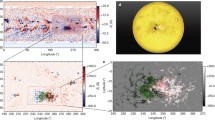Abstract
The analysis of observations of large solar flares made it possible to propose a hypothesis on existence of a skin-layer in magnetic flux ropes of coronal mass ejections. On the assumption that the Bohm coefficient determines the diffusion of magnetic field, an estimate of the skin-layer thickness of ~106 cm is obtained. According to the hypothesis, the electric field of ~0.01–0.1 V/cm, having the nonzero component along the magnetic field of flux rope, arises for ~5 min in the surface layer of the eruptive flux rope during its ejection into the upper corona. The particle acceleration by the electric field to the energies of ~100 MeV/nucleon in the skin-layer of the flux rope leads to their precipitation along field lines to footpoints of the flux rope. The skin-layer presence induces helical or oval chromospheric emission at the ends of flare ribbons. The emission may be accompanied by hard X-ray radiation and by the production of gamma-ray line at the energy of 2.223 MeV (neutron capture line in the photosphere). The magnetic reconnection in the corona leads to a shift of the skin-layer of flux rope across the magnetic field. The area of precipitation of accelerated particles at the flux-rope footpoints expands in this case from the inside outward. This effect is traced in the chromosphere and in the transient region as the expanding helical emission structures. If the emission extends to the spot, a certain fraction of accelerated particles may be reflected from the magnetic barrier (in the magnetic field of the spot). In the case of exit into the interplanetary space, these particles may be recorded in the Earth’s orbit as solar proton events.
Similar content being viewed by others
References
Banin, V.G. and Fedorova, A.S., The strong chromospheric flare of November 5, 1970, in Issledovaniya po geomagnetizmu, aeronomii i fizike Solntsa (Studies on Geomagnetism, Aeronomy, and Solar Physics), Irkutsk: SibIZMIR AN SSSR, 1971, no. 2, pp. 73–85.
Hirayama, T., Theoretical model of flares and prominences. I. Evaporating flare model, Sol. Phys., 1974, vol. 34, pp. 323–338.
Kichigin, G.N., Miroshnichenko, L.I., Sidorov, V.I., et al., Specific features of the strong solar event of July 23, 2002: the particle acceleration source model, in Trudy vserossiiskoi konferentsii “Solnechnaya i solnechno–zemnaya fizika-2010” (Proceedings of the All-Russian Conference “Solar and Solar–Terrestrial Physics- 2010”), St. Petersburg, 2010, pp. 201–204.
Kichigin, G.N., Miroshnichenko, L.I., Sidorov, V.I., et al., Dynamics of accelerated ions in coronal loops and model of a gamma-ray source, Plasma Phys. Rep., 2014, vol. 40, no. 3, pp. 178–193.
Kichigin, G.N., Miroshnichenko, L.I., Sidorov, V.I., et al., Diamagnetic reduction in the magnetic field above a sunspot in the gamma-ray burst on July 14, 2000, Plasma Phys. Rep., 2015, vol. 41, no. 8, pp. 651–655.
Komarova, E.S., Sidorov, V.I., and Yazev, S.A., Specific features of the development of solar flare of October 19, 2001, Soln.–Zemnaya Fiz., 2004, vol. 6, pp. 90–92.
Krall, N.A. and Trivelpiece, A.W., Classical and Bohm diffusion, in Principles of Plasma Physics, New York: McGraw-Hill, 1973; Moscow: Mir, 1975, pp. 25–28.
Kuznetsov, S.N., Kurt, V.G., Myagkova, I.N., et al., Gamma-ray emission and neutrons from solar flares recorded by the SONG instrument in 2001–2004, Sol. Syst. Res., 2006, vol. 40, no. 2, pp. 104–110.
Logachev, Yu.I., Bazilevskaya, G.A., Vashenyuk, E.V., et al., Catalogue of the SEP Events of 1997–2009, 2014. http://kosmofizika.ru/katalog/katalog.htm; http://www.wdcb.ru/stp/online_data.ru.html#ref 113_r.
NOAA, Boulder, Colorado, USA, 2002. http://www.swpc.noaa.gov/ftpdir/indices/SPE.txt.
Sidorov, V.I. and Yazev, S.A., Topological model of the solar event including a flare and coronal mass ejection on October 19, 2001, Cosmic Res., 2008, vol. 46, no. 4, pp. 320–326.
Sidorov, V.I. and Yazev, S.A., Large solar flares and coronal mass ejections: Their manifestations in the chromosphere, Geomagn. Aeron. (Engl. Transl.), 2009, vol. 49, no. 8, pp. 1076–1079.
Sidorov, V.I., Kichigin, G.N., and Yazev, S.A., On the topology of coronal mass emissions in powerful solar flare events, Izv. Irkutsk. Gos. Univ., Ser. Nauki Zemle, 2010, vol. 3, no. 2, pp. 139–155.
Sidorov, V.I., Kuz’minykh, Yu.V., and Yazev, S.A., Solar flare with a surge: Scenario, energy budget, and forecast, Cosmic Res., 2011, vol. 49, no. 4, pp. 308–318.
Sidorov, V.I., Kuz’minykh, Yu.V., and Yazev, S.A., Causes of the divergence of magnetic tube photospheric bases in AR 10930, Geomagn. Aeron. (Engl. Transl.), 2012, vol. 52, no. 8, pp. 1070–1074.
Wentzel, D.G., Solar flares caused by the skin effect in twisted magnetic fields, Astropys. J., 1964, vol. 140, no. 4, pp. 1563–1578.
Yurchyshyn, V., Wang, H., Abramenko, V., et al., Magnetic field, Hα, and RHESSI observation of the 2002 July 23 gamma-ray flare, Astrophys. J., 2004, vol. 605, no. 8, pp. 546–553.
Zaitsev, V.V. and Stepanov, A.V., Coronal magnetic loops, Phys.-Usp., 2008, vol. 51, no. 11, pp. 1123–1160.
Author information
Authors and Affiliations
Corresponding author
Additional information
Original Russian Text © G.N. Kichigin, L.I. Miroshnichenko, V.I. Sidorov, S.A. Yazev, 2016, published in Geomagnetizm i Aeronomiya, 2016, Vol. 56, No. 4, pp. 423–430.
Rights and permissions
About this article
Cite this article
Kichigin, G.N., Miroshnichenko, L.I., Sidorov, V.I. et al. Skin-layer of the eruptive magnetic flux rope in large solar flares. Geomagn. Aeron. 56, 393–400 (2016). https://doi.org/10.1134/S0016793216040058
Received:
Accepted:
Published:
Issue Date:
DOI: https://doi.org/10.1134/S0016793216040058




